No matter how much you feel that your life has hurt you, do not confine your sensibility, just learn to take care of your inner child and love yourself.
Transform your pain into the fullness of Being.
The issue that most worries humans is suffering, unhappiness, feeling pain. We have always been looking for how to be happy.
The ego tries, it has its strategies to protect us from pain, but if it takes power (to the extent that it is successful) it paradoxically ends up getting us into the path of suffering, which is just what it was trying to avoid.
Therefore, the way out is another, it is to transcend it. The ego protects us but does not take care of us, instead the path passes through taking care of us, healing our wound, starting a process based on love and completeness in order to transform our ego into our talent-gift.
This is what this article is about.
And how to facilitate this path in a coaching process.
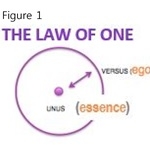 The Law of 1
The Law of 1
As Abdul Karim Baudino explains in his book “The Sufi Enneagram” there is the Law of 1, where 1 represents the center, identity, essence, as opposed to decentralization, which would represent the identification with the ego. As the center is in itself, it is firm, everything else rests on that axis. In essence we are at the center, in ego we are off center.
The Law of One is the Law of Love. The power of attraction that each Essence exerts upon itself. It represents the unifying principle, acceptance. (See figure 1)
So we can already imagine that the way out of suffering has to do with a self-centered being, of course, in contact with his being, his sense, his wisdom.
The problem is that we are off-center trying, even as adults, to meet the expectations of others. We have learned that, being what the Other tells us to be, everything will be fine, we will not feel pain again. That is the world of ego. But it is not like this, on the contrary, the wound that protects the ego ends up being touched, it is inevitable, and the more it tries to avoid it in fear, the more it puts us in a trap of alienation and suffering.
The Other created our wound, but no Other can heal it.
The world through the ego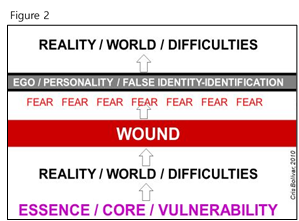
Why can’t we stay focused on completeness with our essence? Why do we devote ourselves to the ego?
Because the ego, which is a defensive psychological structure of social adaptation, tries to protect us from pain, from the pain of our original wound. But, as we have said, the ego does not take care and heals our wound, it only tries to protect it, and it does so through judgment, non-acceptance, non-love, self-demand … and hence the decentralization, the disconnection with the essential being that we are and that we cannot accept because our inner critic, ally of the ego so that we keep to its rules, repeats to us what the Other (main caretaker with whom I establish the dependency links) “installed” on us : “Don’t be like that, be like x, you have to be x for …”. And it denies us, denies our vulnerability by replacing it with a false identity that comes to cover the wound, but not to take care of it. (See figure 2)
The ego says: – Do not worry child, … I take care.
Then it builds the castle, puts up the archers, builds the pit, sets up the cannons …
The child locked in the castle starts to be alone, isolated and wants to leave …
and the ego says:
-No!!!!, you shut up, you be quiet, you stay in there, I am already facing the world.
The ego, in its attempt to protect our vulnerability, our wounded inner child, forgets its very self, alienates itself to adapt to an Other that, in our early childhood, we need to survive. The Other places a demand on our need and opens a hole, a vacuum, a space of non-being that is the wound.
The wound is the feeling of “absence of”, a living through the lack of being due to the construction that I have made of my own self.
When feeling its emptiness, the fear of that emptiness and the pain that it produces, the need arises to fill it, looking for what (passions) through rapid and automatic responses (fixations) that, having been adaptive in their origin and successful sometimes, they lead to strengthening the ego, which, paradoxically, by fortifying it will generate more suffering. It is as if I had an empty glass with a hole underneath (wound), no matter how much we want to fill it we will not be able to until we really repair the hole and accept that we are human beings, vulnerable, limited and imperfect, and that it is alright and at the same time perfect in itself.
How is the ego structured?
We come to the world with an essence, with a nucleus and some possibilities of being, amongst them we are vulnerable beings, half done neurologically speaking: linguistic, symbolic Beings, and Beings with a limbic system, of an emotional experience of pure pleasure-pain. And with that we landed in a world that is everything but perfect or that is perfectly imperfect, as we prefer. And I live pain, helplessness, loneliness, hunger … I feel and the Other I totally depend on responds as he can and knows, placing a demand on me (in symbolic language) that leaves me in dependence.
And so the wound appears, a vacuum, something that is not built, a sense of lack that only the Other can fill to the extent that we respond to their demand.
“If you are good I will love you”, “if … then …”, that each one puts his conditional there, what was he asked for to feel taken care of, protected, loved … to not feel that dreaded emptiness and the pain that it entails.
Fear appears, from the pure limbic system. The limbic system works in a very diffuse way, whatever is minimally similar to what generated the pain will make it react in seconds. From the wound, the trigger will activate the fear of pain and the ego will come into operation, whether it is a wise response or not, out of reactivity, a primary and necessary way that occurs in our early childhood, with the neurological limitations of that period, and insufficient and often problematic in our adult stage. In this way, throughout our life, there will be a certain trigger that, although not being the cause of the wound, will produce the same pain and it will seem to us that it itself is the cause of it. We will perceive it as a real danger when, however, it is only a ghost.
It is never the finger that hurts, but the wound to which it points.
And to protect ourselves from that pain, we will gradually build our ego, our personality and false identity. A filter that distorts us and distorts reality. A filter fed by the fear that is disharmonizing us, disintegrating the initial completeness of our Being. And without realizing it, we go through life with a certain standardized degree of neurosis, psychosis and schizophrenia.
Among all that essence of possibilities of being that we have the potential for, the entire orchestra that we are, we are putting into the shade some of those possibilities of being to stay with those that the Other has “indicated” to us that are valid through the experiences of pleasure and pain that are strengthened through language.
And we get misaligned, decentralizing from our Being to identify with the Being that we have to be and we end up believing that we are, idealization appears and the self-demand to fulfill that idealization. And the more we believe that we are our ego, denying other possibilities of being, the tinier we become. I don’t love myself, I don’t accept myself, I demand myself, I refuse myself, I attack myself, I betray myself, I abandon myself,… and I ask others to do everything that I don’t do for myself, to take care of me for me, to love me for me, to respect me for me, to protect me for me …
And so, more and more disconnected from our essence, from our potential, from vulnerability, more trapped in dependence on the Other to give me what I don’t know how to give to myself, we are getting into a shell that rigidifies us, limits us and makes us victims: the ego.
We are who we are, beings profoundly human, vulnerable, limited,
who can barely know anything and we are trapped in our minds.
Self-knowledge makes us limited beings,
and this is what opens us up to the greatness of being and its possibilities.
Moving from fool to sapiens
The way out is on the path of self-care, the Greek epimeleia heautou.
Epimeleia is an attitude of relationship with oneself, with others, with the world, a look at what one thinks and a way of being. From the Oracle of Delphi we know the formula “know yourself” (gnothi seauton), but, in reality, it was always accompanied by “take care of yourself”, where the knowledge of oneself was a particular case of self-care: the epimeleia.
The fool does not love himself, he is ignorant of himself, he does not love himself because he does not know himself and he does not know himself because he does not love himself. He needs to connect with his inner wisdom, with his ability to love himself out of humility in the completeness of being, that is to go from fool to sapiens.
To grow spiritually is to generate bonds of love with oneself.
That is the way, as we will see later, that the Essential Coaching proposes, whatever the level of consciousness in which the coachee is, the job is to accompany him to his next level of acceptance of himself, of self-care, to transcend the ego and turn it into his talent-gift, connecting with his inner wisdom, healing the wound.
The ego will always be.
The ego is afraid that you will go beyond it, that it cannot protect you, that you cancel it, 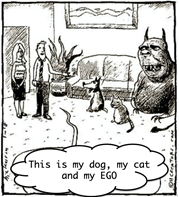 but that is impossible.
but that is impossible.
The only thing you can and
you have to do is put it in its place, learning to watch over you.
And then a miracle will happen …
the ego will become your gift and instead of dominating you,
you will be the artist of your own life, using its colors and its
glow when you decide.
How do we learn? How do we start the transformation process?
“THE 3 BOWLS”. A buddhist metaphor about personal alchemy. (See figure 3)
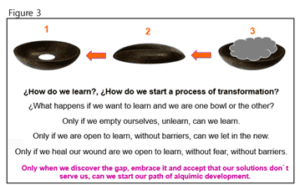
The wound
But how can we heal our wound?
Emotional pain shows us where I have to take care of myself. Instead of protecting me more and more and disconnecting from myself (neurosis), trying to control that I, the other, the world, are as I need them to be, what I can do is give up control and learn to live the experience of Being, in connection with myself, listening to me compassionately, humbly.
The effort from passion and flow makes us grow;
the effort from self-demand and stress dwarfs us
We can say that there are three wounds that correspond to the three great human existential problems. (See figure 4)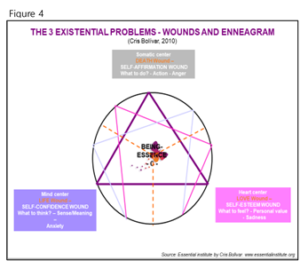
All three affect all of us, but only one really puts us into crisis, only one of these existential gaps is the basis of our ego, and it will try not to make us feel that emptiness because it is painful for us.
The essential separation occurs because we try to avoid pain in one of these three existential problems and their wounds, and that separation is precisely what will cause confusion, ignorance of oneself and reality, and suffering. The price to pay is very high.
The ego lives permanently in the lack,
the essence eternally in the fullness.
Later on, we will see through the Enneagram what are the strategies of the different types of ego to “cover” that wound.
Thus, depending on how our primary environment has been and the perception we have had of it (subjectivation), one type of wound or another will be created. It is impossible not to have a wound, throughout our early childhood, through the Other and the language the existential lack is generated that will structure our ego. Similarly, it is impossible not to have an ego. It is our mechanism of survival as humans, we enter it in a predetermined way. However, getting out of it, transcending it, is a voluntary matter.
And the keys are basic trust and unconditional love, towards oneself, towards the other, towards the world, towards life.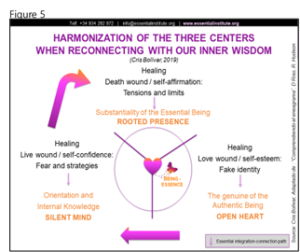
When we heal our wound, inner harmony resurfaces, we come back into connection with our ingrained presence, our quiet mind and our open heart. This allows us to reconnect with our inner wisdom and with the holy ideas of the Enneagram. (See figure 5)
The 3 wounds
The wound of death. Self-affirmation.
The wound of death has to do with the somatic, visceral, the body, with the reptilian brain, the intuitive and being fragile.
What we have learned is that we can disappear at any moment, that we have to cling to life because we are fragile, we have to hold on, affirm, mark a territory, but since there is a self-affirmation wound, this becomes especially problematic, one does not perceive the power to do it.
The lack of a feeling of power to self-assert has to do with doing, with action, and the main emotion that is in the background, manifested or not, is anger, which serves to set limits, it is a wound that is lived in the need for affirmation that one does not perceive in oneself. From the wound, it is a universe focused on limits and tensions. When the wound heals we live in a deep-rooted presence.
The wound of life. Self-confidence.
It has to do with the mental dimension, the head, the cortex, the thought.
It has been created through the emotional experience that this life is difficult, life is threatening, full of dangers and difficulties that I will not be able to face, because there is a wound of self-confidence.
From this wound, I do not trust being able to cope with this difficult, problematic, complex life, and it is hard to find its meaning. I don’t perceive myself with the personal resources to face it, and I feel that capacity gap. Therefore, what is lived in a diffuse and more or less conscious way is fear, there is a background tone of anxiety. And what the ego will try to cover that existential void is a mental strategy where to anticipate, control, predict, organize, plan, know or avoid … these possible threats so that they do not put us in check, because it is convinced that we will not be able to face them.
From the wound, it is a universe focused on the threats that are yet to come and the difficulty of trusting oneself to face them. When the wound heals we live from a quiet mind, we rely on our internal orientation.
The wound of love. Self-esteem.
Related to the emotional dimension, the limbic system, the heart or the emotional brain.
The wound of love has to do with the emotional experience of not being worthy of being loved, not having felt seen, self-esteem has not been built and therefore love will be looked for outside. It is oriented towards bonds, relationships, in what to feel to know the value that one has for another, as a measure of being as one should be because one does not perceive the own value or dignity of being loved that is intrinsically attached to being a human being. The main emotion is the sadness that produces the loss of the value of being, of not being worthy of being loved.
From the wound, it is a universe focused on the difficulty in establishing bonds of love and the pain they can generate.
When the wound heals we live from the open heart and can perceive love in everything.
Let’s see an example of all this …
For example, imagine that we are fired, there may be different reactions to this … It could be that we don’t care … we perceive it as a complicated situation, perhaps difficult or even uncomfortable, but we simply tell ourselves that we will have to look for employment again and that’s it. … although we no longer have a fixed salary, although we have to give up stability or certain comforts, it does not put us in crisis. Why? Because we may have a wound of love, and since my being has not felt questioned, we do not feel that we have been fired for not being as we had to be (for example they have closed the company), maybe it annoys or bothers us, but it doesn’t hurt. On the other hand, the same situation for someone with a wound of life would put him in crisis, because although he understands that he has been fired independently of him, it makes him feel without soil, without security, touched in his ability to face a difficulty.
Similarly, if we have a wound of death, I will not focus on whether I am able to push forward, I know that I am, it will not take my sleep away if I have been a good colleague or not … what will affect me is feeling weak, for example that an injustice has been committed against me and I have not been able to defend myself, that there has been an abuse of power against me or even against my colleagues. In this case, that will be what really touches me and exposes me to my wound.
Many times it is not easy to identify the wound, for example a coachee says: “I do not want to be abandoned.” We might think it is a wound of LOVE. But when we ask what happens if they leave you? and he replies: I would not know what to do in this life, I would not feel capable of … We see that what actually exists seems to be rather a wound of self-confidence.
The wounds and the egoic response in the Essential Enneagram Approach
In order to understand the wounds and egos they generate, it is useful to work with the Essential Enneagram, or the philosophical-psycho-spiritual approach of the Enneagram from our essential viewpoint or Essentiality.
Each of these wounds, as shown by the Enneagram model, is covered by one of the three types of ego of each center, providing 9 Enneagram types, that means 9 wound protection strategies, 9 possible personalities that, all together, would form the essence to which to return once the ego itself has been transcended. (See figure 6)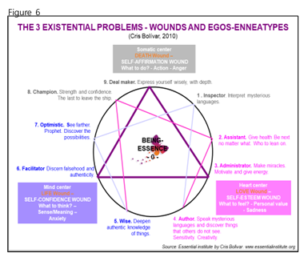
In fact, 9 was for the ancient Egyptians, cradle of the Enneagram, the symbol of totality.
The central triangle (neurotic triangle) of the Enneagram would be formed by the three wounds: the wound of DEATH (self-affirmation), whose somatic center is located in enneagram type 9, which it shares with the ennea8 and ennea1; that of LIFE (self-confidence) in enneagram type 6, which shares this mental center with the ennea5 and the ennea7; and the wound of LOVE (self-esteem) in enneagram type 3 that shares the emotional center with ennea4 and ennea2.
Egotypes of the wound of life, mental center (5, 6 and 7).
The egos that are protecting from not feeling the wound of life do so through mental strategies, where the management of the mental becomes the difficulty. If one feels that in a usual way it becomes difficult to read reality, to interpret it, that one enters the mental loop out of a diffuse anxiety, it is possible that there may be a wound of life in the background.
Ennea5 confronts this, accepts that life is difficult and complicated which is why he pulls out, trying to stay in a situation of objectivity where situations do not affect him to discover what this is about and face it. He seeks knowledge in depth, research and emotional withdrawal to be able to handle it in this objectivity, in order to face the difficulties that may come from life. His tangled side is greed, he needs more of everything,
More resources, he lives in a sense of lack. On his gifted or luminous side, that is, when he is well integrated, through the integration of all enneagram types, he would be the wise, who sees things and can discriminate against them.
Ennea6 tries to respond to his basic fear by looking for safety nets since he does not believe in himself, he does not believe in his ability to decide without making mistakes, so he looks for people or situations where he can get support, for example, a partner who knows, a family, club, team, etc. On his dark side he would be the coward and on his positive side he would be the loyal, the cooperative.
The ennea7 in the presence of difficulties what he does is to go to another world where there are still no difficulties, because if he stays in this one he always believes that they will reach him in the end, so he is always on the lookout for the next, for example, the next party, project, relationship, etc. On his problematic side, he would be the hedonist, Peter Pan, who never lands, who does not materialize, on his talented side he would be the optimist being an expert in seeing the possibilities that life brings.
Egotypes of the wound of death, somatic center (8, 9 and 1).
They revolve around the wound of self-affirmation and the emotion of anger that can be extroverted, introverted or ambivalent depending on the type of ego. They try to cover the feeling of lack of power and personal influence, the feeling that one is fragile and vulnerable, and where one can disappear from this world either physically or symbolically, for example, that they take away my space. Therefore they are oriented towards doing to maintain these limits. In any of the three cases the management of the corporal-visceral-intuitive is problematic when you are in the trap of these egos.
Ennea8 acts with confrontation, he is attentive to who is in charge here, if the other has the power he will feel weak therefore he has to have it, he believes that he is the strongest, I have more authority and power than the rest. His side of sin is lust and on his bright side he would be the champion, the boss, the last to leave the ship.
The ennea9 that is in the triangle which is why he recognizes himself the least, faces this wound by trying to be invisible, acting from the non-action, trying to keep his space by seeking that no one sees him because he believes that he will get it that way, so if no one sees me I do not enter into conflict then I do not bother and do not hinder anyone, therefore, he begins to over adapt and in this game he is ambivalent with the wound, for example, he tries to remain silent to not generate any conflicts but at the same time in that silence, there comes a minute when he explodes. In his sin there would be the mental laziness of not moving in order to not having to cope and in his gift the peacemaker, who knows how to keep in harmony.
Ennea1 acts in a more conceptual way: one must be that way, the world functions in such a way, this is my limit, this is what I decide. The wound is internalized and there is anger when those own rules, of what must rigorously be accomplished in the world so that the world is as it should be, are not being fulfilled. On his negative side he is the perfectionist and on his positive side he is the one who knows how to detect when something is wrong to improve it.
Egotypes of the wound of love, emotional center (2, 3 and 4).
They are focused on how one needs to be to have value through the other loving them, therefore, they will try to cover the wound of self-esteem trying to create value through the other, thus obtaining the love that one does not give oneself. The three egos, when they get entangled, generate difficulty in emotional management.
The ennea2 believes to solve his wound by giving, my worth happens through giving, if I give they will love me, this movement implies that I cannot recognize my need as otherwise I would put myself in danger, therefore the sin is pride and on his positive side there is a motherly, helpful, serviceable aspect.
Ennea3 is on the axis of the neurotic triangle, the one that least recognizes himself, the most inauthentic one that identifies with the role it plays, that role that is successful, that achieves what others are asking, to be recognized and to that extent have personal value, in his sin there would be vanity and in his gift the achiever, the one who accomplishes miracles.
The ennea4 solves it by being special, I am rare and in my rarity comes my sense of being, my value. He is covering this feeling of low dignity, he hides it with the fact that I am unique and nobody understands me, I am different from others, in his sin there would be envy as there is a feeling of lack that makes him feel that he does not have what others have and in his light he would be creative since in that desire to be special he dares to do things that others would not do because they would be too unusual.
The idea would be to gain in self-knowledge and recognize the enneagram type, the ego that is behind it and ask us: what are you doing? what are you trying to cover? why have we built this false image? so that I can recognize this wound before paying attention to the ego and to tell it: “so far you have protected me but now I take care of myself” and so I start building my sense of self-esteem, self-confidence or self-affirmation.
The in-depth description of each enneagram type-ego strategy can be found in reference books such as “The Wisdom of the Enneagram” by Riso – Hudson.
The path to healing: the ego becomes our talent-gift
Only when we discover and accept the existential void (the gap) and see that our egoic strategies do not help us, can we begin the path of alchemical development, where this void of fragility transmutes into magic vulnerability that reconnects us to our sensibility, love, peace, completeness, sense, intimacy, enjoyment, creativity… (See figure 7)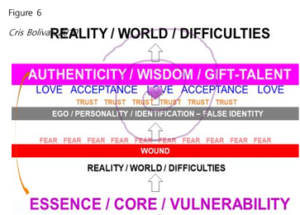
Stop fighting with your human condition, renounce control and power, surrender …
transform your fragility into greatness.
For this, it is necessary to learn to transcend our inner critic from love. We must learn to listen to our inner child, which is where our injured child is, our vulnerability, sensitivity, sense, … if we block it so as to not feel pain, it ends up somatizing or our basic desire is distorted, generating need, dependence and suffering.
Caring for one leads to caring for another,
very different from caring for another to take care of one.
The issue is how we get in touch with our inner child. Through emotional pain.
It informs us of our wound and that helps us to heal it through the connection with genuine trust and love, transcending fear, allow us to relax and tell ourselves “whatever it is it will be fine because that’s the way it is”, without judgment, judgment comes from what my ego thinks is right or wrong in the attempt not to touch the wound, because it is afraid that it hurts … but we know already where that path leads.
However, from the care of oneself (which is accompanied by self-knowledge), things will affect us less, we will gain freedom to be, fullness and well-being, we can direct our lives taking care from the viewpoint of acceptance.
Loving me is giving me permission and freedom to be, whatever comes up.
Loving ourselves is what allows us to enter that space of wisdom, we are reconnecting again with the essence, leaving duality and returning to completeness, to live fully.
When you stop fighting with yourself, your gift flourishes.
In the symbol of the Enneagram, as we already saw, the circle represents this completeness of Being, the law of 1, of Love; the triangle symbolizes creation, the law of 3, the harmonizing principle of wisdom to evolve towards nonduality; and finally the hexagram or the law of 7 that speaks of the process of this creation, of its stages and movements, it indicates us that this is not about absolute terms, it is a lifelong process, an evolutionary spiral. Although we will get stuck on the way, it will seem to us to go backwards and then we may experience suffering, frustration, helplessness, stress, anxiety, apathy … but it is because we live the process out of ignorance, through the glasses and the judgment of our ego. (See figure 8)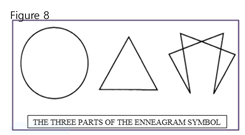
However, if we trust the process, trust in our wisdom, if we learn to distinguish the messages of our ego and pay less attention to them, if we transmute our ego into our talent, then we will exit the dead-end street by changing direction, we will experience less reactivity, less anxiety, more fluency, harmony and well-being.
It will help us to understand that the process of the Essential Being is bi-directional, and that we should facilitate what increases the connection with it while decreasing what blocks it. (See figure 9)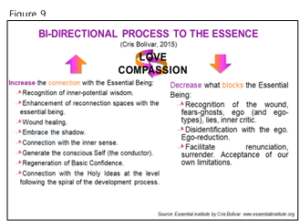
Out of FEAR … I live in lack.
If I don’t have what I need, I get into stress, and if I have it, it doesn’t usually make me happy.
Out of the ESSENCE … I live in abundance.
If I don’t have what I want, it doesn’t affect me, and if it happens, it usually makes me happy
The work in Essential Coaching: from the ego to the essence.
In Essential Coaching we focus on accompanying this process, reading through PARDES (kabbalistic tool of hermeneutic reading which helps to focus on reading different levels of depth) to facilitate awareness and self-knowledge of the ego that protects the wound, so that the coachee can reveal it with love and compassion to heal it and transcend its ego so that it is not limiting and can manifest itself from its potential to achieve meta-results or extra-ordinary results. For this we use a model that guides the process. (See figure 10)
The coach’s function is not to fatten the ego, but to facilitate transcending it, because there is the true potential to be found.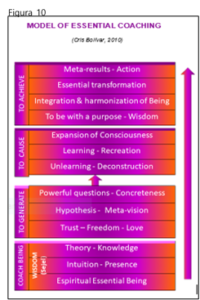
Transcend the ego by welcoming and listening to the inner child from the acceptance of being and facilitating the ego to develop polarity, embrace the shadow, expand contact with the essence, with the uniqueness of the different energies of being (enneagram types) to move from a false identification to an identity more in line with the reality of being … generating wisdom.
The way back to the essence. A path to wisdom.
It is a path of love, love of oneself and life. A path without fear.
A way of gratitude. A path of humility and trust.
A path to authenticity, essence, totality.
A path to clarity and light. An awakening.
Coaching session: The case of “Acting or Not Acting, that is the question”, or a wound of death.
Demand of the coachee:
I wish I could be more efficient. I think I have problems with laziness.
Synthesis of the significant telling of the coachee:
I realize that I should be more efficient, take action, that I have to deal with certain situations, but an opposite force arises in me that leads me not to. Sometimes I tell myself it’s not worth it, that I won’t get anything out of it. Other times, I just let myself go by my routines and habits where I feel most comfortable and to which I end up dedicating all my time. In other occacions, when I finally get down to doing what I know I have to do, the details take up all my time. I also feel a deep resistance within me that silently opposes anything I feel I am told to do. I think I let myself be overcome by laziness and leave for another day what I would have to do today. I do not know why.
Law of 3:
Through a Core Quadrant of the Voice Dialogue, the coachee identified two opposing energies that played a relevant role that were worked with the Enneagram’s law of 3 and from what emerged (See figure 11):
Hypothesis:
Egotype 9
Lines of work:
Awareness of the ego´s vision and its trap. Integration of polarity, work with obstacles and resistances and with the elements that facilitate the harmonization of the being towards the desired evolutionary position out of duality.
Some Essential Coaching tools:
Essential Enneagram Approach.
Core Quadrant and Voice Dialogue.
Metaphors.
Meditation.
Some key questions:
Why always be in your being in harmony?
What could happen if you are not always in harmony?
What danger is there?
Why laziness, what benefit does it bring you?
What is efficiency for you?
Are harmony and efficiency incompatible?
What opportunity would arise if you allowed yourself to be more efficient, to take action?
What has to happen in you to be able to manage the tensions in a more evolutionary way for you?
How to gain inner power?
How to act from presence and inner peace?
Coaching session: The MAG case, or a wound of life
CB: We were talking before about the topic of the wound. Let’s get a little more into that. It seems that there is something in you that has to do with doubt, with getting support … You have said that it seems that you are in a place where it is very difficult to get out of this doubt. Make me a little aware of the situation you want to bring. Tell me.
MAG: Well, it’s that although “mentally” you can get the idea that “yes, life is learning”, “the important thing is the way”, etc., after all, they are just ideas. On the other hand and unintentionally, you end up analyzing past experiences and interpreting them as unsuccessful, although “mentally” you also accept that if at that time you acted as you acted, you did it with the tools you had at your fingertips at that time. That is, it is a mistake to interpret it retrospectively, as “easy to say in hindsight”, that is, “I had to have realized that …!”, “I should have thought …!”, “I should have warned …! ”
CB: And what do you do it for? What is the use?
MAG: Theoretically it should help me so that the experience was not only an experience, but also a learning. That is, if situations arose again that had a certain parallelism with others that I have already lived, knowing how to get my decisions right more properly.
CB: Well, it sounds good so far. You want to learn from the past, from experience, and try to take advantage of it so that it will help you for an upcoming experience. But you say that is problematic for you. What’s up with that?
MAG: I get the impression that I don’t get the learning because sometimes I get the impression that you’ve seen yourself in similar situations and that you are mistaken again.
CB: What is being mistaken for you?
MAG: Well, making a decision that may not have had the ideal consequences, or the ideal results, or the best possible results …
CB: How do you know which are the best results or the ideal results?
MAG: Well, you don’t know, you suppose.
CB: Based on what?
MAG: Based on a series of rational assumptions, of course, based exclusively on rationality. On hypothesis.
CB: So what …?
MAG: So they are not based on realities.
CB: Let’s see if I understand you. I will put my words to see if I follow you. Tell me if it’s like that or not. It would be something like expectations, like “I want this to happen,” “this has to happen,” “I need this to happen,” and one makes decisions based on that, and then it turns out that it doesn’t happen.
MAG: Yes, that´s it! And it turns out you’re mistaken, and you say “I shouldn’t have made this decision …”
CB: I mean, “you are mistaken” means that the expectation was not fulfilled.
MAG: Yes.
CB: That is, “you are mistaken” means that what you needed or wanted to happen does not happen.
MAG: Yes.
CB: And then, what could you do there?
MAG: What I would like to do would be to be more intuitive, or to be smarter in relation to what I was commenting before getting more out of previous experiences …
CB: What would it be like to be smarter, more intuitive?
MAG: Well, that. Get it right (laughs).
CB: And getting it right means …
MAG: That expectations are met.
CB: So something like being a fortune teller? or how to control the world?
MAG: Maybe. It doesn´t always have to be, but to a favorable percentage.
CB: That the world adjusts to you. Are we talking about that?
MAG: Man, I suppose that the majority of actions that I carry out, seek to make the world adjust to me to some extent, yes.
CB: The majority and to a certain extent, or much more than that? Because it seems that it generates a lot of noise that what you want to happen doesn’t happen.
MAG: Well, yes. Yes. Well, now I do not know if I leave the question but I have the impression that there are other people, that they do have a series of qualities (that if you ask me what they are, I would not know how to say them) thanks to which yes they get the world to meet their expectations, in a higher percentage than what I get.
CB: And you would like to be one of those people who get the world to meet your expectations …
MAG: Yes.
CB: What for?
MAG: To feel better, right?
CB: What do you mean? What happens to you when the world does not meet your expectations?
MAG: That you get frustrated. That you get frustrated and feel incapable.
CB: So when the world does not meet my expectations, what does it mean, that things happen that I don’t like, that don’t suit me, or simply that they are not under my control?…
MAG: Yes, well, I know that I can’t be God to control and handle everything, but between being God and being a “human little awake” …
CB: Give that a tougher qualifier. How is someone who does not control the world and that things happen in spite of him?
MAG: Inept. Being inept.
CB: So, in order not to be incapable and inept, the world has to meet your expectations, right? The test is to have special skills that others seem to have and that make the world meet their expectations. How does this sound to you? Does it sound good to you?
MAG: Man! The first thing that may sound strange to me is that, after all, I suppose that others have abilities, but since I am not ” the other,” I really do not know if “the other” has any ability or not. As I am not ” the other”, I do not know exactly to what extent their expectations are realized. One thing is what you see from the outside and another that maybe “the other”, from his own being, does not see that they are fulfilled, however much it seems to me that he is successful, that he had a project and then things have adjusted to it, etc. But… well, at least from the outside, it seems like this.
CB: Does something else catch your attention? That the world meets our expectations as a measure of not being incapable or inept, how does that sound to you?
MAG: Well, maybe not either. The case we were discussing in another session, the simple Balinese fisherman who probably lives without any expectations, or the one on the back cover of “La Vanguardia” today, who has given up the consumer society and simply lives, moving in a wagon pulled by a mule and with four basic belongings. However, I do not believe that with my life experience and with everything “what you have inside”, I might be able to adopt a perspective like that one. But maybe something like a midway point, something more balanced, would be fine.
CB: So, you think that not being incapable or inept has to do with controlling things so that what you want happens.
MAG: Yes … Yes, the truth is that what you say doesn’t sound so bad to me. Something fails because as far as control is concerned, how much can you get to control? How many things are in your hand? In your hand there is only one part, others depend on other parts of the “system”, where there are many things that influence. But maybe those four things that are in my hand, I would like to have them better controlled.
CB: Do you think that you have no control over things? Is that your level of worthlessness, ineptitude?
MAG: Yes, it can be. To think that I have little control over things.
CB: What would it be like to have more control?
MAG: What would it be like to have more control? Maybe what we said before; to be smarter. And what is being smarter? Maybe you have more vision. And what is having more vision? Anticipate and meet expectations. Clear! If you start talking about “vision,” what are you trying to see? You are trying to see an expectation.
CB: Well, let’s try to locate this mess to see if it works for you and close it to set a focus to work on. It seems that there is something that has to do with, “I am there, and I want to control to get here,” yes? In the path and context, I have no idea what happens, but you have to close and place what has to happen at the end because you say “what I need.” This can be called expectation: I, here, now, today, have an idea of how things should turn out. Whereupon, when you have reached that point, it may have happened and it may not. If it matches the idea that I have had, I will say that I am successful. If it does not match, I will say that I am inept, a failure,or whatever.
And you put everything in that “there”; “If I had done this …”, “I would have done that …”, etc., would have happened x ….
You do not question the expectation itself, the construction that you have made up. You question what you have done or have not done along the way. And you question that having seen certain things, you could have set another expectation. But there has to be an expectation. So let’s focus the issue on some aspects. First, the world of expectations, what is it about ?; What relationship does it have for you to get an idea in your head, about what has to happen in the world? Why does what´s in your head have to happen in the world? Second, let’s assume that I have a desire, that I am craving something, and I go to the world and start doing things to make it happen. How is that happening? That intuition, that vision that you place on “less inept” people, is it because they want something and move threads, cause and effect, to achieve it? Or is it made out of seeing the whole picture, learning to see how they correlate things and constantly flow within the idea they have of how things are going? Do I explain myself? Is the difference understood?
An assumption: I want you to like me. So, if I’m smart, I’ll do things so you like me, for example, being nice, for example smiling. As a result, you have to like me, if not, I am an inept, and I don’t know how to make myself liked by people, and I get frustrated, and I feel incapable, and I feel inept … etc., because I don’t get you to like me. But if you like me or not, it doesn’t just depend on me. The world does what it wants and I don’t know all the variables. Maybe as much as I smile, as I have brown eyes, you will not like me yes or yes, because you do not trust people with brown eyes at all. So, what do I do to you? If I need you to like me to make sure that what I think is correct and that I am not an inept. Because if I don’t get you to like me, it is being questioned that I don’t know how to do things. Do you see this mess, how it is constructed? But the fact that you don’t like me doesn’t just have to do with how I do things. It has to do with you, too. And this variable “world”, “the other”, it seems that you do not read it. You need to close an expectation. You need to close a concrete idea on which to access and put your energy there to prove you something.
I think we should start releasing something, to relocate. Do you see this “crazy” idea that something has to happen for me to feel capable, based on my expectation and my idea of how that should happen? Do you see this game? How does it sound to you now, seen from what we talked about?
MAG: You’re quite right. That I ride my own “ball”, and of course, everything happens inside my own ball. Actually, maybe I would have to be more humble, and realize that I can’t be a god. Consequently, I don’t have to accept that I have to be able to control all the things that happen in this world. And surely the measure of my ability will not only be in my results.
CB: How does it sound to accept and know that you are only a human, that you cannot do everything, and do not know everything, and do not control everything? How does that sound?
MAG: It gives peace of mind.
CB: Well, let’s stay here for now. We have the issue of expectation, that of control, the idea that things work linear with cause and effect, and that of needing your expectation to happen as a measure of your ability …, and we also have that, perhaps, it would be a wiser viewpoint to accept you as human. Yes?, ok?, then focus your attention on this and we leave it here for today.
Coaching case: the CC Case (Cardboard Box), or a wound of self-esteem.
Demand of the coachee:
See what happens to me in relationships that do not work out for me. I do not dare to get involved until the other does not give me proof that I am the chosen one.
Injured child:
Fear of not being chosen for “not being enough of whatever” appears. The memory emerges when the coachee was 3 years old, clearly visualized, lived almost with the emotional intensity of that moment: her father hugs her mother, her mother looks at her as if saying “he is mine, I am the chosen one”, the coachee remembers feeling her mother’s mockery at her shame for falling short.
Ego:
From then on, she seeks to be loved through what she does, what she gets, through being a good girl, and above all, of being like her mother, convinced that she herself will never be able to feel up to par, she will not be the chosen one.
Dynamics: Convinced that I am not worthy, “I don’t show the gift that I am because deep down I don’t think there is a “gift”, so I protect myself against the possibility of not being the chosen one by boycotting situations where my being could be exposed, I put a thousand tests that the other has to overcome and I remain in my shell justifying myself saying that the other does not deserve me. I can only open the gift that I really am to the one who chooses me, who chooses me based on the cardboard box I show him.”
The other walks away tired of seeing only the cardboard box (shell-ego), the critic does not allow anything to be shown of what she is, all intimacy is blocked, someone who she does not desire is chosen to show intimacy, convinced that there is nothing worth showing because she is not up to par, any other woman is better, and every effort is made to prove this to protect the injured child from being injured again.
And so the wound and the ego that tries to protect it remain, while fueling the suffering, isolation, guilt, fear and feeling of low personal worth.
Trap: Hide, boycott relationships so that they never discover that there is nothing inside the cardboard box (which is what the inner critic believes). Safeguard oneself justifying that the other does not deserve one to show.
Hypothesis: Wound of self-esteem, egotype3.
Focus and intervention strategies in Essential Coaching:
- Unveil the ego and take away its power to give it to a space of inner wisdom.
- Addressing the wound to heal it through compassion and love towards the injured child updating the experience: she is no longer the girl in front of her mother, she is a complete woman.
- Strengthen confidence in the face of fear of intimacy, of showing herself and of rejection.
- Disempower the inner critic and his messages.
- Bring the discoveries to experience with the consciousness to generate a new emotional experience.
Some key questions:
- What are you testing for?
- What are you trying to protect?
- What would happen if they chose you?
- What are you trying to keep?
- What are you trying to avoid?
- What is the fear?
- Why do you avoid intimacy?
- Why do you choose the men you choose?
- What do you tell yourself?
- Are you now the 3-year-old girl? Who are you now?
- Where are you acting from when you protect yourself?
- Where could you be acting from to trust?
- Who has to love you?
- Who should lower your defense?
- What can you do differently?
- What other messages can you tell yourself?
Some Essential Coaching tools:- Voice Dialogue.
- Essential Enneagram Approach.
- Visualization of the inner child.
To find oneself, find again, recognize and love oneself in the immense beauty that one is.
The author. Cris Bolívar.
- Founder and CEO of the Essential Institute.
- Essential Coach, consultant, trainer and international speaker.
- MCC, Master Certified Coach – International Coach
- Federation, ICF (USA), first Spanish to obtain it, 2004.
- Mentor Coach by the ICF.
- Former Vice President ICF-Spain.
- Creator of Essential Coaching (2005).
- Co-creator of the CSE (Systemic Enneagram Configurations) (2014).
- Degree in Organizational Psychology (University of Barcelona).
- Degree in Philosophy (University of Barcelona).
- Master Consultant in Organizational Development (Israel).
- Raja Yoga Meditation, Brahma Spiritual University
- Kumaris (India). Sufism. Cabala.
- Formed with Boyatzis, Maturana, Jodorowsky, Naranjo, Daniel Ben Yitzchak, Mario Saban,…
- Painter and poet.
- Author of various books and articles.
- Recognized by the General Council of Official Psychology Colleges among the most relevant authors since the 20th century for their contribution to coaching.
- Recognized by Vikki Brock (expert in the history of coaching) as a pioneer and reference of coaching in Spain.
- Recognized as a Life Teacher by Mestresdevida.cat
- Accredited by the IEA -International Enneagram Association- as an Enneagram Professional.
See expanded CV on http://essentialinstitute.org/cris-bolivar/
Bibliography
- Almaas, A. H. “Facets of unity”. Ed. Shambhala
- Baudino, A. K. “El eneagrama Sufí”. Huwa Ediciones
- Gallen, A-M. “El eneagrama de nuestras relaciones”. Descleé de Brouwer
- Riso, Hudson. “The Wisdom of the Eneagramm”. Bantam



